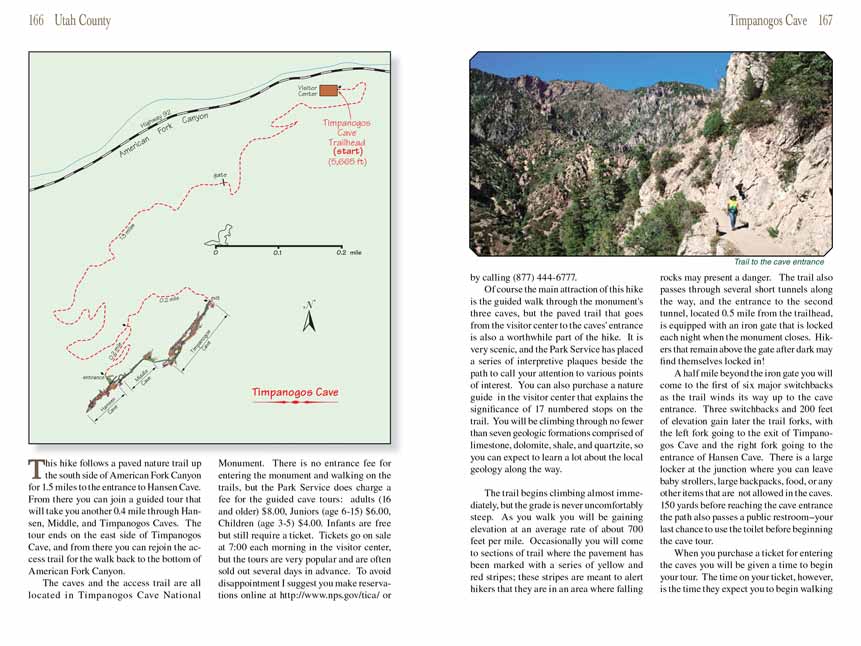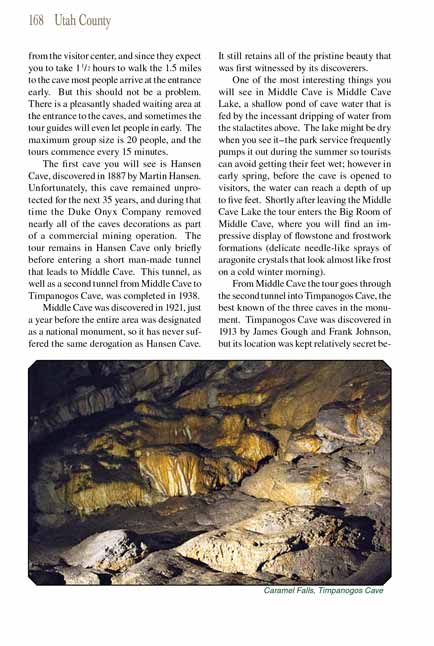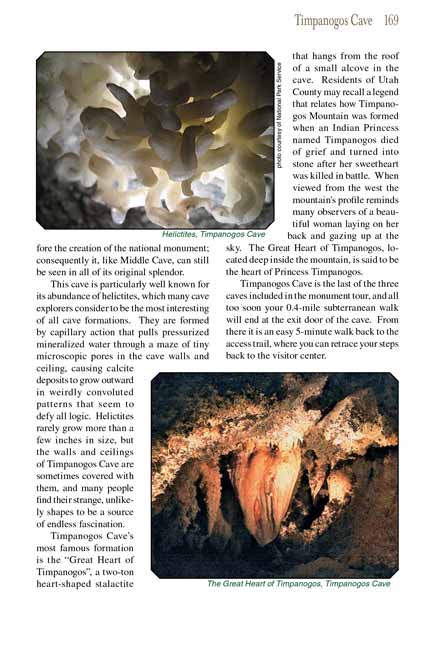Timpanogos Cave
excerpted from our book
Salt Lake City's Incredible Hiking and Biking Trails
pages 165-169
|
Buy book directly from the author!
Salt Lake City's Incredible Hiking and Biking Trails
- has access info for 73 trailheads
- 73 colorful trail maps
- 325 full color photographs
- loads of hiking tips
|
regularly $19.95
now on sale for only
$9.95
click here
for book orders
|


 This hike follows a paved nature trail up the south side of American Fork Canyon for 1.5 miles to the entrance to Hansen Cave. From there you can
join a guided tour that will take you another 0.4 mile through Hansen, Middle
Cave, and Timpanogos Cave. The tour ends on the east side of Timpanogos Cave, and from there you can rejoin the access trail for the walk back to
the bottom of American Fork Canyon.
This hike follows a paved nature trail up the south side of American Fork Canyon for 1.5 miles to the entrance to Hansen Cave. From there you can
join a guided tour that will take you another 0.4 mile through Hansen, Middle
Cave, and Timpanogos Cave. The tour ends on the east side of Timpanogos Cave, and from there you can rejoin the access trail for the walk back to
the bottom of American Fork Canyon.
The caves and the access trail are all located in Timpanogos Cave National Monument. There is no entrance fee for entering the monument and walking
on the trails, but the Park Service does charge a fee for the guided cave tours: adults (16 and older) $8.00, Juniors (age 6-15) $6.00, Children (age 3-5)
$4.00. Infants are free but still require a ticket. Tickets go on sale at 7:00 each morning in the visitor center, but the tours are very popular and are
often sold out several days in advance. To avoid disappointment I suggest you make reservations online at http://www.nps.gov/tica/ or by calling (877) 444-6777.
Of course the main attraction of this hike is the guided walk through the
Timpanogos Cave National Monument's three caves, but the paved trail that goes from the visitor center to the caves' entrance is also a worthwhile part of
the hike. It is very scenic, and the Park Service has placed a series of interpretive plaques beside the path to call your attention to various points of
interest. You can also purchase a nature guide in the visitor center that explains the significance of 17 numbered stops on the trail. You will be climbing
through no fewer than seven geologic formations comprised of limestone, dolomite, shale, and quartzite, so you can expect to learn a lot about the local geology
along the way.
The trail begins climbing almost immediately
toward the entrance to Timpanogos Cave, but the grade is never uncomfortably steep. As you walk you will be gaining elevation at an average rate of about
700 feet per mile. Occasionally you will come to sections of trail where the pavement has been marked with a series of yellow and red stripes; these stripes
are meant to alert hikers that they are in an area where falling rocks may present a danger. The trail also passes through several short tunnels along the
way, and the entrance to the second tunnel, located 0.5 mile from the trailhead, is equipped with an iron gate that is locked each night when
Timpanogos Cave National Monument closes. Hikers that remain above the gate after dark may find themselves locked in!
 A half mile beyond the iron gate you will come to the first of six major switchbacks as the trail winds its way up to the cave
entrance. Three switchbacks and 200 feet of elevation gain later the trail forks, with the left fork going to the exit of Timpanogos Cave and the right fork
going to the entrance of Hansen Cave. There is a large locker at the junction where you can leave baby strollers, large backpacks, food, or any other items
that are not allowed in the caves. 150 yards before reaching the cave entrance the path also passes a public restroom-your last chance to use the toilet
before beginning the cave tour.
A half mile beyond the iron gate you will come to the first of six major switchbacks as the trail winds its way up to the cave
entrance. Three switchbacks and 200 feet of elevation gain later the trail forks, with the left fork going to the exit of Timpanogos Cave and the right fork
going to the entrance of Hansen Cave. There is a large locker at the junction where you can leave baby strollers, large backpacks, food, or any other items
that are not allowed in the caves. 150 yards before reaching the cave entrance the path also passes a public restroom-your last chance to use the toilet
before beginning the cave tour.
When you purchase a ticket for entering the caves you will be given a time to begin your tour. The time on your ticket,
however, is the time they expect you to begin walking from the
Timpanogos Cave Visitor Center, and since they expect you to take 1 1/2 hours to walk the 1.5 miles to the cave most people arrive at the entrance early. But
this should not be a problem. There is a pleasantly shaded waiting area at the entrance to the caves, and sometimes the tour guides will even let people in
early. The maximum group size is 20 people, and the tours commence every 15 minutes.
The first cave you will see is Hansen Cave, discovered in 1887 by Martin Hansen. Unfortunately, this
cave remained unprotected for the next 35 years, and during that time the Duke Onyx Company removed nearly all of the caves decorations as part of a commercial
mining operation. The tour remains in Hansen Cave only briefly before entering a short man-made tunnel that leads to Middle Cave. This tunnel, as well as a
second tunnel from Middle Cave to Timpanogos Cave, was completed in 1938.
Middle Cave was discovered in 1921, just a year before the entire area was designated as a national
monument, so it has never suffered the same derogation as Hansen Cave. It still retains all of the pristine beauty that was first witnessed by its discoverers.
One of the most interesting things you will see in Middle Cave is Middle Cave Lake, a shallow pond of
cave water that is fed by the incessant dripping of water from the stalactites above. The lake might be dry when you see it-the park service frequently pumps
it out during the summer so tourists can avoid getting their feet wet; however in early spring, before the cave is opened to visitors, the water can reach a depth
of up to five feet. Shortly after leaving the Middle Cave Lake the tour enters the Big Room of Middle Cave, where you will find an impressive display of flowstone
and frostwork formations (delicate needle-like sprays of aragonite crystals that look almost like frost on a cold winter morning).
From Middle Cave the tour goes through the second tunnel into Timpanogos Cave, the best known of the
three caves in the monument. Timpanogos Cave was discovered in 1913 by James Gough and Frank Johnson, but its location was kept relatively secret before the
creation of the national monument; consequently it, like Middle Cave, can still be seen in all of its original splendor.
This cave is particularly well known for its abundance of helictites, which many cave explorers consider
to be the most interesting of all cave formations. They are formed by capillary action that pulls pressurized mineralized water through a maze of tiny microscopic
pores in the cave walls and ceiling, causing calcite deposits to grow outward in weirdly convoluted patterns that seem to defy all logic. Helictites rarely grow
more than a few inches in size, but the walls and ceilings of Timpanogos Cave are sometimes covered with them, and many people find their strange, unlikely shapes
to be a source of endless fascination.
Timpanogos Cave’s most famous formation is the “Great Heart of Timpanogos”, a two-ton heart-shaped stalactite
that hangs from the roof of a small alcove in the cave. Residents of Utah County may recall a legend that relates how Timpanogos Mountain was formed when an Indian Princess named Timpanogos died of grief and turned into stone after her sweetheart was killed in battle. When viewed from the west the mountain's profile reminds many observers of a beautiful woman laying on her back and gazing up at the sky. The Great Heart of Timpanogos, located deep inside the mountain, is said to be the heart of Princess Timpanogos.
Timpanogos Cave is the last of the three caves included in the monument tour, and all too soon your 0.4-mile
subterranean walk will end at the exit door of the cave. From there it is an easy 5-minute walk back to the access trail, where you can retrace your steps back to
the visitor center.
Note to web developers: You may copy this material onto your site, but in return please include a link to my home page
www.utahtrails.com. Thank you, David Day (utahdavidday at gmail.com)
Click here to see more
trails near Salt Lake City
© Rincon Publishing Company, all rights reserved
|


 This hike follows a paved nature trail up the south side of American Fork Canyon for 1.5 miles to the entrance to Hansen Cave. From there you can
join a guided tour that will take you another 0.4 mile through Hansen, Middle
Cave, and Timpanogos Cave. The tour ends on the east side of Timpanogos Cave, and from there you can rejoin the access trail for the walk back to
the bottom of American Fork Canyon.
This hike follows a paved nature trail up the south side of American Fork Canyon for 1.5 miles to the entrance to Hansen Cave. From there you can
join a guided tour that will take you another 0.4 mile through Hansen, Middle
Cave, and Timpanogos Cave. The tour ends on the east side of Timpanogos Cave, and from there you can rejoin the access trail for the walk back to
the bottom of American Fork Canyon.
 A half mile beyond the iron gate you will come to the first of six major switchbacks as the trail winds its way up to the cave
entrance. Three switchbacks and 200 feet of elevation gain later the trail forks, with the left fork going to the exit of Timpanogos Cave and the right fork
going to the entrance of Hansen Cave. There is a large locker at the junction where you can leave baby strollers, large backpacks, food, or any other items
that are not allowed in the caves. 150 yards before reaching the cave entrance the path also passes a public restroom-your last chance to use the toilet
before beginning the cave tour.
A half mile beyond the iron gate you will come to the first of six major switchbacks as the trail winds its way up to the cave
entrance. Three switchbacks and 200 feet of elevation gain later the trail forks, with the left fork going to the exit of Timpanogos Cave and the right fork
going to the entrance of Hansen Cave. There is a large locker at the junction where you can leave baby strollers, large backpacks, food, or any other items
that are not allowed in the caves. 150 yards before reaching the cave entrance the path also passes a public restroom-your last chance to use the toilet
before beginning the cave tour.